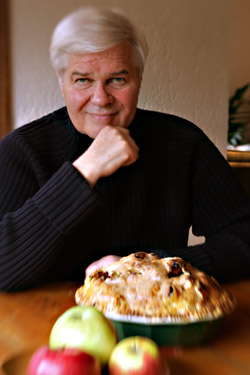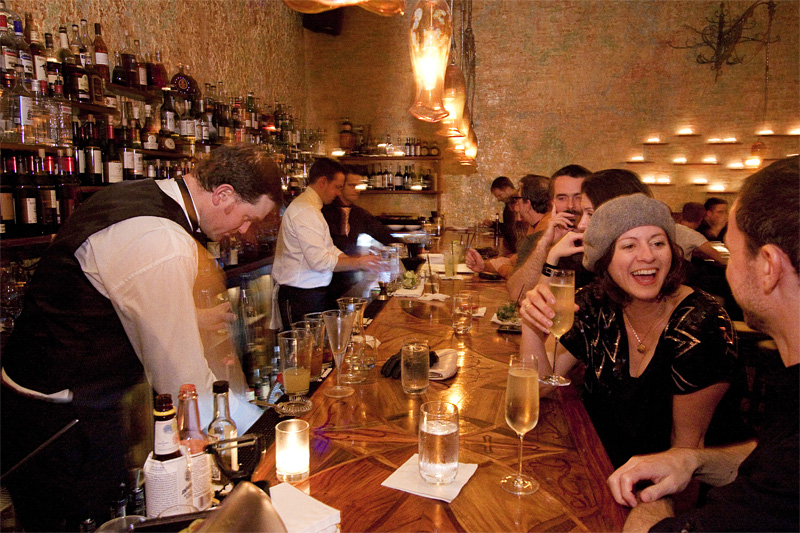Though you may not notice it at first, Jon Rowley is quite the raconteur. He doesn’t act out dialogue or sketch figures in the air with his hands. He just starts telling you about something, slowly and intently, and as the minutes pass, you find that you need to hear more.
In just this manner—quiet, improbable— Rowley has shaped Seattle’s food scene as few others have: by teaching cooks, waiters, retailers, and farmers how to enthrall diners with the story of good food. Without Rowley’s efforts, you might not taste oysters quite so meditatively, or buy strawberries quite so sweet. His work over the past 30 years has touched every aspect of the food scene, which is why the judges of Seattle Weekly’s new annual Pellegrini Award have selected him to be their inaugural recipient.
The award—named after UW professor, winemaker, gardener, and author Angelo Pellegrini—honors distinguished contributions to food in Seattle. Pellegrini’s books from the 1940s and 1950s have inspired generations of local cooks, and each time one is reprinted, he inspires yet another. Jon Rowley has done the same.
Awards judge Bruce Naftaly, chef of Le Gourmand Restaurant, says, “Jon has been instrumental in raising everybody’s consciousness about what seafood can be, and applying that to other foods as well. He is tireless in his pursuit of the perfection of flavors.”
Rowley’s wife, Kate McDermott, calls her husband’s quest for flavor his “particular reason for being here.”
Rowley, a Reed College–educated, Alaska-based fisherman, steered his salmon boat up and down the coast for years. But when he moved to Seattle permanently in 1979 and sold his boat, he realized how awful this fishing town’s fish was: not just the preparation but the raw product. At the time, fish often ended up at the market after spending more than a week in the bottom of the hull of a ship, pressed under thousands of other fish, before being bled (too late), cleaned (too late), and portioned (onto little Styrofoam plates). You may remember, or perhaps your parents do, the smell of it.
It was the stench of supposedly fresh fish that Rowley ordered at Rosellini 610 that caused him to complain about his entrée to Robert Rosellini, son of the restaurant’s owner (and future chef of Rosellini’s Other Place). Rosellini didn’t bite back. Instead, he convinced his critic to go into business selling seafood.
The pair persuaded a few Neah Bay fishermen to catch and prepare their fish as Rowley had learned on his trips to Europe and the East Coast. Rowley then trained cooks how to prepare the pristine fish in ways that didn’t involve deep-frying or heavy sauces, and taught waiters how to sell the superior product to diners.
The fish business closed within a year—neither partner had the capital nor the experience to handle R&R Seafood’s instant success—but it changed Seattle’s seafood forever. Rowley impressed so many people in the industry in a single year that restaurants and markets soon clamored to hire him as a consultant. “I developed a knack early on of making other people money,” Rowley laughs. He’s done everything from designing grocery seafood counters to discovering and promoting Copper River salmon.
It was when he launched the Peach-O-Rama promotion at the former Queen Anne Thriftway that he discovered the refractometer, a device used by winegrowers to measure the Brix levels (sweetness) of their grapes. Rowley used the refractometer to search out the Northwest’s best peach orchards and determine the optimal time for picking and shipping.
He didn’t stop at peaches, though. He started measuring the Brix levels of all the fruits at the farmers market, and then all the vegetables, too. He discovered that asparagus and kale with the highest Brix levels express their true flavors most strongly; even more importantly, that high Brix level correlated directly with the amount of organic matter in the soil in which the plant was grown. Rowley spent many hours sharing his knowledge with local farmers about how to improve their crops, and then he delved into compost, volunteering with the Interbay P-Patch for many years to revitalize its soil and foster its sense of community.
Friends and colleagues agree that Jon Rowley combines business savvy not just with personal integrity but also with joy in living well. As Chris Curtis, Seattle Neighborhood Farmers Markets coordinator, says, “Jon is good not only at taking food to the level it needs to be at, but also at taking the time to savor it and respect it.”
Rowley would rather talk to you about what he has just tasted than about what drives him. But some clue emerges when he talks about Pellegrini: “When you read Angelo Pellegrini,” he says, “there’s this sense of the table, and everyone around the table’s lives being better for what’s on the table, and life in the community that these people live in being better because of what’s on the table.” Likewise, our lives are better because of Jon Rowley’s quest.






